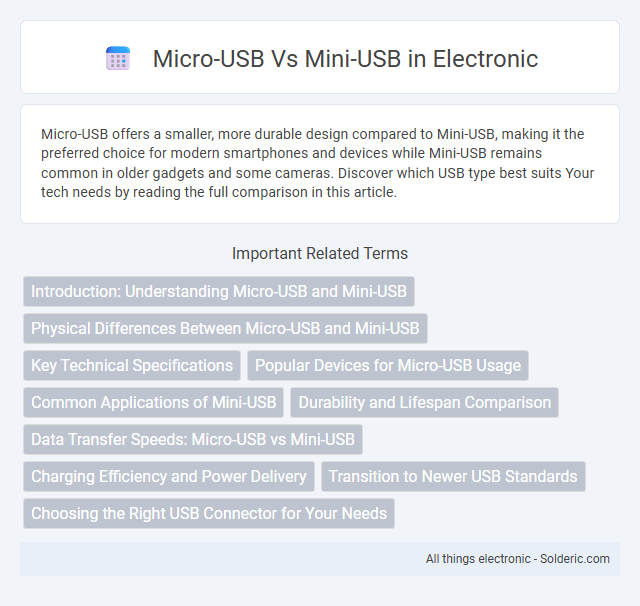Micro-USB offers a smaller, more durable design compared to Mini-USB, making it the preferred choice for modern smartphones and devices while Mini-USB remains common in older gadgets and some cameras. Discover which USB type best suits Your tech needs by reading the full comparison in this article.
Comparison Table
| Feature | Micro-USB | Mini-USB |
|---|---|---|
| Connector Size | Smaller (6.85mm x 1.8mm) | Larger (7.5mm x 3mm) |
| Common Uses | Smartphones, tablets, accessories | Older cameras, MP3 players, GPS devices |
| Durability | Up to 10,000 connection cycles | Up to 5,000 connection cycles |
| Data Transfer Speed | Supports USB 2.0 (up to 480 Mbps) | Supports USB 2.0 (up to 480 Mbps) |
| Release Year | Introduced in 2007 | Introduced in 2000 |
| Compatibility | Widely adopted; standard for many devices | Less common; mostly legacy devices |
Introduction: Understanding Micro-USB and Mini-USB
Micro-USB and Mini-USB are two common standards for USB connectors used primarily for charging and data transfer in portable devices. Micro-USB, introduced after Mini-USB, offers a smaller, slimmer design optimized for modern smartphones, tablets, and other compact electronics, supporting USB 2.0 or 3.0 protocols. Mini-USB, larger and less common today, was mainly used in older devices like digital cameras and external hard drives, offering durability but lower compatibility with current technology trends.
Physical Differences Between Micro-USB and Mini-USB
Micro-USB connectors are smaller and thinner, measuring approximately 6.85mm wide, compared to Mini-USB connectors, which are about 7.75mm wide and thicker. Micro-USB ports feature a tapered, compact design that fits modern slim devices, while Mini-USB ports are bulkier and typically found on older cameras and portable gadgets. Your choice between Micro-USB and Mini-USB affects device compatibility and cable size, influencing data transfer convenience and charging efficiency.
Key Technical Specifications
Micro-USB connectors feature a smaller form factor with a width of 6.85 mm and are designed to support USB 2.0 data transfer rates up to 480 Mbps, commonly used for smartphones and portable devices. Mini-USB connectors, measuring approximately 7.8 mm wide, were prevalent in earlier devices but have lower durability and bulkier build compared to Micro-USB, with similar USB 2.0 speed capabilities. Both types typically provide 5V power delivery, but Micro-USB supports higher insertion cycles of around 10,000 compared to Mini-USB's 5,000 cycles, reflecting improved durability in modern devices.
Popular Devices for Micro-USB Usage
Micro-USB connectors are commonly found in a wide range of popular devices including Android smartphones, tablets, Bluetooth headphones, portable power banks, and gaming controllers. Many budget and mid-range electronics still rely on Micro-USB for charging and data transfer due to its widespread compatibility and cost-effectiveness. Your device may use Micro-USB if it is an older model or falls within categories that prioritize affordable and versatile charging solutions.
Common Applications of Mini-USB
Mini-USB connectors were commonly used in older digital cameras, MP3 players, and some early smartphones, providing a compact and reliable interface for data transfer and charging. Their small size made them ideal for portable devices that required durable and straightforward connectivity. If you still have older gadgets, understanding Mini-USB can help you find compatible cables and accessories for seamless operation.
Durability and Lifespan Comparison
Micro-USB connectors feature a more compact design with reinforced pins, offering improved durability over Mini-USB in high-frequency usage scenarios. Mini-USB ports typically endure up to 5,000 insertion cycles, while Micro-USB connectors support approximately 10,000 cycles, doubling lifespan expectations. The robust structural enhancements in Micro-USB reduce wear and tear, ensuring extended device compatibility and reliability.
Data Transfer Speeds: Micro-USB vs Mini-USB
Micro-USB supports USB 2.0 standard with data transfer speeds up to 480 Mbps, while Mini-USB typically adheres to USB 1.1 with maximum speeds of 12 Mbps. Devices using Micro-USB benefit from faster data transfers, making it preferable for modern smartphones, tablets, and portable electronics. Mini-USB remains in use for older devices but is limited by its lower transfer rates compared to Micro-USB.
Charging Efficiency and Power Delivery
Micro-USB connectors typically support faster charging and higher power delivery compared to Mini-USB, making them more efficient for powering modern smartphones and tablets. The increased pin configuration and improved design of Micro-USB enable better current flow and reduced power loss during charging. When choosing between the two, your device's compatibility and the charger's output rating will significantly impact overall charging efficiency.
Transition to Newer USB Standards
The transition from Mini-USB and Micro-USB to newer USB standards like USB-C reflects advancements in data transfer speeds, power delivery, and device compatibility. Micro-USB, more compact than Mini-USB, was widely adopted for mobile devices but faces obsolescence due to the reversible design and higher functionality of USB-C. Your choice to upgrade to devices featuring USB-C ensures better future-proofing and enhanced performance compared to older USB connectors.
Choosing the Right USB Connector for Your Needs
Micro-USB connectors are smaller and more durable than Mini-USB, making them ideal for modern smartphones, tablets, and compact devices requiring frequent plugging and unplugging. Mini-USB, being larger, is commonly found on older devices like digital cameras and some external hard drives, offering a sturdy connection but less suited for slim gadgets. Selecting the right USB connector depends on device compatibility, data transfer speed, and physical durability requirements.
Micro-USB vs Mini-USB Infographic

 solderic.com
solderic.com